Vintage NOMA Christmas tree STAR OF BETHLEHEM with Antique Mazda light String Set
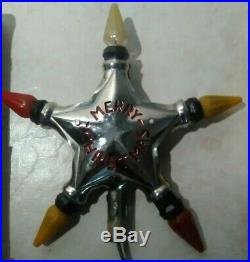
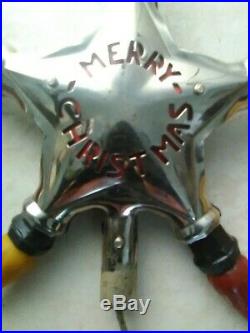
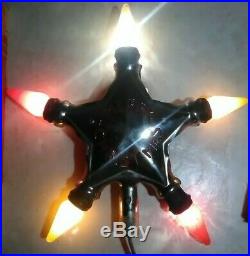
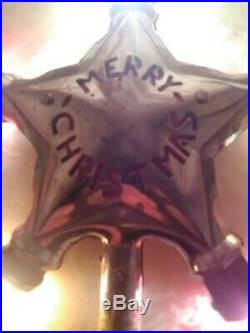

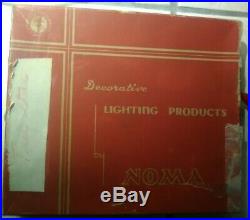
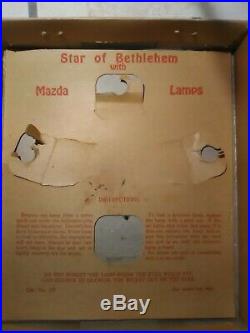
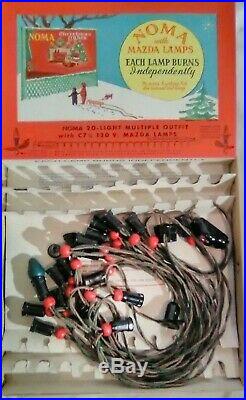
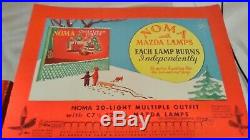
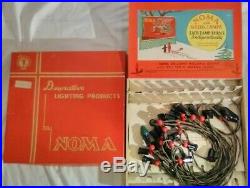
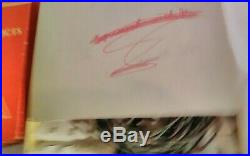
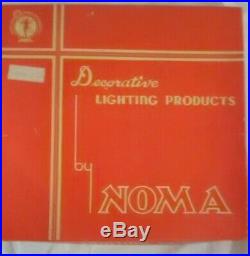

Vintage NOMA Christmas tree light topper STAR OF BETHLEHEM with Mazda lamps in original box. The cord is black taped below the star and the light kinda flickers when I pick it up so I think the connection needs to be redone. There is a white bulb in the center that lights up the Merry Christmas in red - I think it would be brighter with a clear bulb instead of white. Also included is the box of.
Vintage NOMA Christmas Lights with red Beads 20 Light Set in Original Box C-7. There Is only one Vintage Green Mazda bulb on the string that turned on when I plugged it in, I did not try the bulb in every socket to see if they all worked.
There is a note written on the box that these connect to the star so I think this set has been kept together for all of these years,,,,,, Even the boxes look like the same advertising theme. The history of NOMA Electric Corporation is a complicated one. NOMA was the largest Christmas lighting company in the world for all of the years of its operation prior to 1965.
Here is what I have been able to discover about the story of a company that began by revolutionizing the American electric Christmas lighting industry.. The early years of the 20th century saw a growing public interest in electric Christmas tree lighting.
In the beginning the lights were considered just a novelty, but as more and more cities were wired for electricity, the advantages of electric tree lighting became obvious. General Electric offered the first sets to the public, followed closely by the National Ever Ready Company (still known today for their Eveready brand batteries). A man by the name of Albert Sadacca and his two brothers, Henri and Leon, had started a lighting company in about 1914, and their business was beginning to grow rapidly in the area of decorative Christmas lighting. Louis Szel, an executive with the Five Seas Trading Company, had been importing beautiful figural Christmas lights from Austria into the United States since 1909 and was also enjoying a good bit of success.
Other companies in business at the time included the M. Wood Electric, The Interstate Electric Novelty Company (later known as Franco) and the Henry Hyman Company. An eight light set was barely enough to light a table top sized tree, while various numbers of lights were required to accommodate other tree sizes.
Lighting dealers were encouraged to carry all four sizes in order to offer the widest variety to their customers. The sets were quite expensive, and it was a bit of an economic gamble for dealers to carry a big variety and risk having a large quantity remaining unsold at the end of the season. A crude form of extension box had been available for several years which allowed sets to be adjusted for the number of light strings connected to it, but it was not the most practical of devices. The box allowed additional festoons of eight lights each to be added by opening it up, and connecting wires to the appropriate places. Here is a picture of a typical example, which is made of heavy green glazed ceramic and was called a junction box.
In 1921, Lester Haft of the C. Wood Electric Company filed a patent application for a device and method of allowing additional festoons of lights to be easily connected to one another.
Lester Haft and His 1924 Patent. On this site for more information about this pivotal patent. The benefits of Haft's patent were immediately obvious, and most of the companies then in the Christmas lighting business either licensed the rights to incorporate the device in their own strings or defied the pending patent, hoping the application would not be approved. But Haft's patent was granted in 1924, a defining year for the Christmas lighting industry. Wood Electric in order to incorporate the device into their Christmas lighting strings. Propp organization, challenged the patent and lost. Small companies, who chose not to pay for the license prior to the patent being granted, found themselves strapped for cash as sales plummeted. Many of the companies gave in, and licensed the rights to use the connectors in their strings. The Sadacca Brothers, Albert, Henri and Leon, proposed that a trade organization be started, whereby any company who wanted to would be able to join, reducing licensing and advertising costs to everyone. Accounts of the number of companies who joined vary from thirteen to fifteen, but I do know that these companies were involved: The C. Wood Electric company, Szel's Five Seas Trading Company, The Tinsel Corporation of America, The Matchless Corporation, the decorative lighting division of Deal Electric, Franco, the decorative lighting division of Monowatt and The Henry Hyman Company. The United States Electric Company, better known as USALITE, joined for a short time but then broke away. A major holdout was the M. Propp Company, who continued (for a time, at least) on their own.The Association was a great success. Late in 1926, it was proposed and accepted by the association members that they officially merge into one company, and the famous NOMA Electric Corporation was born. The American Christmas lighting industry was to be changed forever. Aggressively marketed and advertised, the company enjoyed stellar sales.
Interestingly, Morris Propp, the owner and founder of the company that was once NOMA's largest competitor, became the president of NOMA Electric in 1931. He held that position until his untimely death of a brain tumor in 1933. The formation of NOMA Electric dramatically reduced the number of decorative lighting companies in business in 1927. As the market leader, NOMA began to offer a huge variety of electrical decorative accessories and lighting outfits to the public, and set the competitive example for other lighting companies to follow.
Through their years of operation, NOMA Electric developed and/or marketed many "firsts", including the Tri-Plug connector (this differs from the Tatchon devices in that the Tatchons are typically found at the end of the string rather than on the wall plug itself), the adjustable berry bead fasteners to allow proper positioning of lights on the tree (acquired in the merger with Propp), intermediate base outfits for outdoor decorating, bubble lights, and the safety fuse plug (still in use today). Below is a brief timeline of some of the important events in the history of NOMA Electric Incorporated. This was a trade association only, and not an official company.Companies officially merged into a single company: NOMA Electric Corporation. Offers intermediate base outdoor light set for the first time as set number 3000: NOMA Multiple Outfit.
Offers candelabra based multiple wired lighting sets for indoor use. Sells the lighted character bells for the first time. Subjects included the Mickey Mouse characters and the gang from Walt Disney's Silly Symphonies cartoons. Introduced the plastic halo, a decorative piece that provided a warm candle flame-like glow around a single light bulb. For the first time, sells an all-rubber cord with their outdoor lighting set. Even the sockets themselves were rubber coated in this outfit. WAR YEARS-NO NEW ITEMS OFFERED During these years, the company diversified dramatically. Introduces Bubble Lites to the world.(There are claims that the year might have been 1945, but if true, few were marketed in that year). Offers the new GE G-14 lamps in sets of seven as Glo Ray outfits.
Changes Bubble Lite base from "biscuit" shape to "saucer" shape. Reverts to "biscuit" base shape for Bubble Lites. (Sells through overstock of saucer shaped bubblers as well). Introduces the "Safety Plug" with fuses in the plug itself, an invention still in use today. "Spins off" and changes the name of the electrical decorative light division of NOMA Electric Corporation to NOMA Lites Incorporated. This was done to differentiate their manufacture of Christmas lights from many other products the company was making at the time. Opens an additional manufacturing plant in St. Introduces the "Safety Socket" to go with the "Safety Fuse Plug". The sockets have permanent clips, and a solderless flow-through wire design that prevents loose connections. The beginnings of the effects of huge amounts of foreign imports are felt financially.Changes their famous Bubble Lites to a rocket style due to increasing public awareness of and interest in the "space race". Imports are now having a serious affect on NOMA. Substantial financial struggling due to competition from increasing imported, less expensive electrical Christmas lights and decorations. Stops production of rocket type bubble lights, and sells Peerless style of bubblers. The company will never again be the super power that it once was.
Late in this year, NOMA is reorganized as Noma Worldwide, Incorporated. Sells mostly imported goods for the 1965 Christmas season. Licensed NOMA products will now have a? Symbol by the NOMA name. NOMA/Worldwide sells almost 100% imported products. The NOMA name for Christmas lights is currently licensed by Inliten, LLC. The item "Vintage NOMA Christmas tree STAR OF BETHLEHEM with Antique Mazda light String Set" is in sale since Sunday, October 6, 2019. This item is in the category "Collectibles\Holiday & Seasonal\Christmas\ Modern (1946-90)\Lights".The seller is "2004online" and is located in Wausau, Wisconsin. This item can be shipped to United States, Canada, United Kingdom, Denmark, Romania, Slovakia, Bulgaria, Czech republic, Finland, Hungary, Latvia, Lithuania, Malta, Estonia, Australia, Greece, Portugal, Cyprus, Slovenia, Japan, China, Sweden, South Korea, Indonesia, Taiwan, South africa, Thailand, Belgium, France, Hong Kong, Ireland, Netherlands, Poland, Spain, Italy, Germany, Austria, Bahamas, Israel, Mexico, New Zealand, Philippines, Singapore, Switzerland, Norway, Saudi arabia, Ukraine, United arab emirates, Qatar, Kuwait, Bahrain, Croatia, Malaysia, Chile, Colombia, Costa rica, Dominican republic, Panama, Trinidad and tobago, Guatemala, Honduras, Jamaica, Iceland, Sri lanka, Uruguay, Russian federation.
- Featured Refinements: Vintage Christmas Lights
